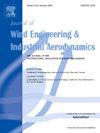In-line force modeling for a circular cylinder in oscillatory flow with non-zero mean velocity
IF 4.9
2区 工程技术
Q1 ENGINEERING, CIVIL
Journal of Wind Engineering and Industrial Aerodynamics
Pub Date : 2025-04-12
DOI:10.1016/j.jweia.2025.106109
引用次数: 0
Abstract
Three-dimensional large eddy simulation (LES) of oscillatory flow with non-zero mean velocity around a circular cylinder is carried out at Reynolds number Re = 15000 to investigate the effects of amplitude ratio (AR) and Keulegan-Carpenter (KC) number on wake structure and fluid forces. The applicability of two-term and three-term Morison equations for modeling the time histories of in-line force is examined. The results show that both AR and KC strongly influence the vortex pattern. The drag coefficient (Cd) of Morison equations increases from a small value with KC first and then decreases and converges to the value of mean drag force in steady flow, with a peak presented when the value of AR/KC is around the Strouhal number (St0) in steady flow because of resonance effect. This tendency is more significant at higher AR values. The three-term Morison equation exhibits better performance in modeling the in-line fluid force when AR/KC > St0/3, i.e., the oscillation frequency is greater than three times the vortex shedding frequency in steady flow. In addition, the revised KC number is not appropriate for modeling the flow force in oscillatory flow with non-zero mean velocity.
非零平均速度振荡流中圆柱的直线力建模
在雷诺数Re = 15000条件下,对非零平均速度绕圆柱振荡流动进行了三维大涡模拟,研究了振幅比(AR)和kulegan - carpenter (KC)数对尾迹结构和流体力的影响。考察了两项和三项莫里森方程在模拟直线力时程中的适用性。结果表明,AR和KC都对涡型有强烈的影响。Morison方程阻力系数Cd随KC先增大后减小并收敛于定常流时的平均阻力值,且由于共振效应,在定常流中AR/KC在Strouhal数St0附近时出现峰值。这种趋势在较高的AR值时更为显著。当AR/KC >时,三项Morison方程在模拟在线流体力方面表现出较好的性能;St0/3,即振荡频率大于定常流动时旋涡脱落频率的3倍。此外,修正后的KC数不适合模拟平均速度非为零的振荡流的流力。
本文章由计算机程序翻译,如有差异,请以英文原文为准。
求助全文
约1分钟内获得全文
求助全文
来源期刊
CiteScore
8.90
自引率
22.90%
发文量
306
审稿时长
4.4 months
期刊介绍:
The objective of the journal is to provide a means for the publication and interchange of information, on an international basis, on all those aspects of wind engineering that are included in the activities of the International Association for Wind Engineering http://www.iawe.org/. These are: social and economic impact of wind effects; wind characteristics and structure, local wind environments, wind loads and structural response, diffusion, pollutant dispersion and matter transport, wind effects on building heat loss and ventilation, wind effects on transport systems, aerodynamic aspects of wind energy generation, and codification of wind effects.
Papers on these subjects describing full-scale measurements, wind-tunnel simulation studies, computational or theoretical methods are published, as well as papers dealing with the development of techniques and apparatus for wind engineering experiments.

 求助内容:
求助内容: 应助结果提醒方式:
应助结果提醒方式:


